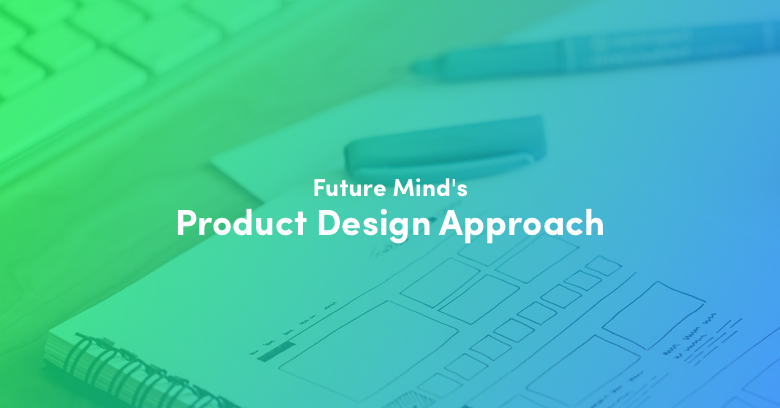
What is the best approach to product design when we consider the project phase, software goals and business reality (meaning limited time and resources)? Based on our 10-year experience in designing digital products we were able to create 3 most common scenarios in which we help customers design proper solutions and smoothly advance to product development phase.
Disclaimer — we do not stick to one methodology. Our main focus is to fulfil customer's needs and meet business goals. That is why you'll encounter words like “need”, “strategy” and “goal” quite often in this entry. Learn how to get prepared for joint Product Design and how that process is conducted.
TL;DR go straight to your problem :
1. You have an idea or a business issue and need professional help, someone to guide you through the whole process — New Product Design .
2. You have a strategy, business requirements, sketches and you need professional help with completing the designs and advancing to the development phase — UX and UI Design .
3. You have a working product and you want to improve it, e.g. shorten the purchasing journey by solving user issues, adding new features or refreshing graphic design — Product Redesign .
Before our collaboration begins you should be able to define the challenge that stands before your organisation or product. In the first case it could be “How should we adapt our product portfolio to satisfy constantly changing preferences of the Millennials”. To best define the problem be sure to discuss it with all people that are involved in that area.
To best define the challenges that await your organisation we recommend using the method described in the “Scaling Up” book . It will help you collect in-house feedback, discuss issues with stakeholders and examine what you may have to face, all described in an organised, orderly fashion. After that, you'll be able to establish your vision, strategy, company goals and tasks for all project members on two A4 pages. We employ this method ourselves and it helped us grow by 40% in the last year alone. You'll find all necessary resources here .
Not knowing your business goals would make our work a guessing game. Product features and graphic design must comply with its goals. Show us your problem and goals in as precise form as possible and we will help you design your product.
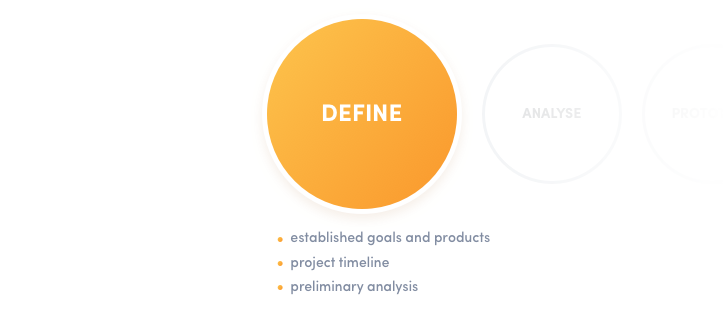
Define
In the case of an already existing product we begin with UX Audit which is an audit designed to check how your product fairs in terms of usability and business goals. When it comes to an existing product your goal might be solving design issues, improving graphic design and adding new features that will better suit user needs and solve business problems. That is why it is so important to define how we may help you. We will know that after workshops performed at the beginning of our cooperation.
Whichever form our cooperation will take at the beginning, we will always start with showing you the project flow, containing info on what actions will be taken and what products you'll receive at each project stage. We'll also present the results of our UX Audit (if you are improving existing software) and preliminary market analysis concerning similar products (if you are building a new app with us). We'll also prepare first hypothesises that we'll continuously update and improve.
Products of this stage : established goals and products that we want to build, timeline, multi-layer audit or preliminary benchmark analysis.
Analyse
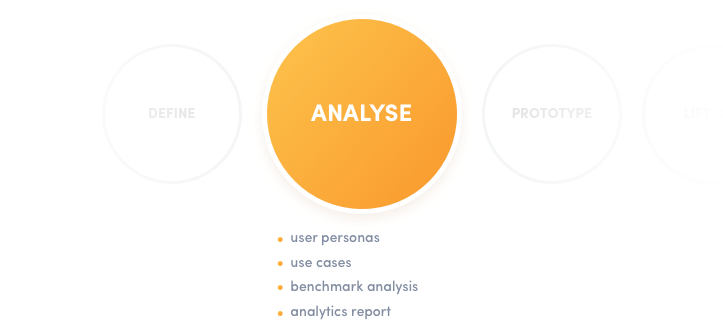
Armed with knowledge gathered during the analysis we establish user personas, i.e. your perfect customers. Personas are the base that we'll build the use cases on. Use cases are descriptions of situations in which your product will be used. If your software is already accessible to users we analyse it using tools like Google Analytics, Hotjar etc.
Based on all gathered data we prepare functionality proposition in form of a MoSCoW matrix which enables us to prioritise and divide functionalities into Must (mandatory), Should (it would be profitable to add them), Could (it would be nice to implement them) and Won't (we don't need them) categories.
Products of this stage : user personas and use case descriptions, benchmark analysis report, analytics report (prepared using proper tools in case of an already existing product), functionality list in form of a MoSCoW matrix (or a process diagram).
Prototype – doing things right
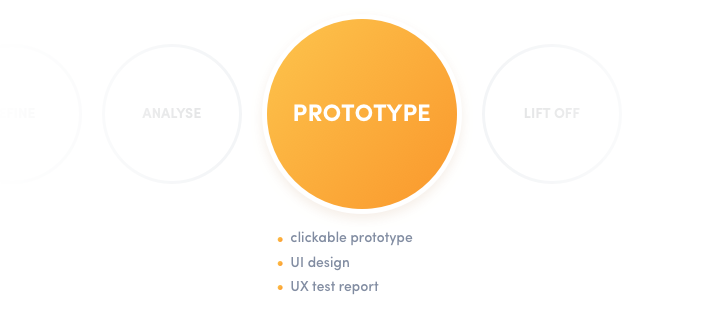
First screen flow draft (concerning navigation between screens) takes a form of a very basic wireframe, while our prototypes should take a form of a graphic layout as soon as possible. We believe that to gain most out of the user tests a prototype must closely resemble the final product. Experienced designers and product owners navigate crude black and white mock-ups with ease, but after many years of product development we know that user who sees a given interface for the first time needs more than that. So let's not skip colours and graphic design in UI. They help organise data and direct user through proper steps.
The design process is performed in several iterations (we create from a few to dozen or so versions), each aimed to perfect the product and add new functionalities, better suited for the final application software, its utility and component coherence.
0k, but what about prototype tests?
When we agree that the prototype is ready for the first users we arrange first practical tests. There is an interesting approach to user tests described by Jason Hreha (Head of Product in Wallmart).
We usually perform moderated one-on-one tests during which we aim to provide maximum comfort to the tester. We ask a series of open questions, give simple tasks and closely observe the tester, write down their feedback and questions. The test is recorded to enable its later thorough analysis. Test results are translated into a list of bugs, UX issues and other feedback along with proposed solutions and issue prioritisation (from low through medium and serious to critical).
Products of this stage : clickable prototype, set of screens prepared according to the graphic design, UX test report (prioritised and arranged using the NPS) and style guide.
Lift off
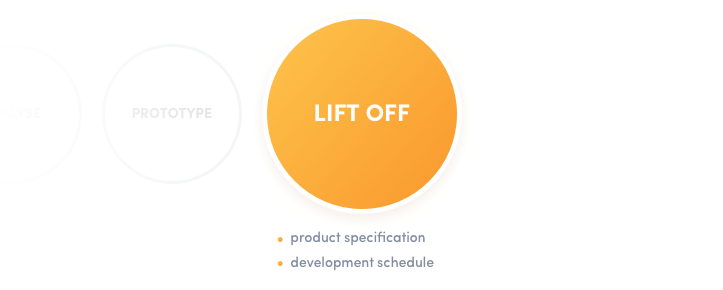
What's more, we create a product roadmap, containing milestones. Roadmap allows all project members to stay on the same page in terms of deadlines, priorities and project scope. Thanks to this approach you'll be able to plan how to utilise your resources, minimise risks and limit costs.
Products of this stage: product specification containing feature and non-feature requirements, mock API, timetable, roadmap.
As you can see we do not stick strictly to one process when it comes to collaboration with our customers. We try our best to suit individual needs. We believe that business process is like a cooking recipe — at first you go by the book, after that you tune it according to your taste and needs. Contact us, and we'll prepare a delicious product for you ;).